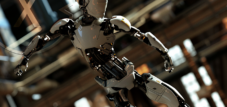Published on: June 7, 2025 / update from: June 7, 2025 - Author: Konrad Wolfenstein

Jump from the Rivian van: steel colleague instead of post messenger? Amazon's humanoids in the test - Image: Xpert.digital
From drones to humanoids: Amazon's next step in delivery automation
Amazon's test program for humanoid robots: transformation of the last mile in logistics
The recent developments in Amazon mark an important turning point in the logistics industry, since the company tests humanoid robots for parcel delivery and works with the electric vehicle manufacturer Rivian. This initiative illustrates a strategic relocation of traditional, earmarked automation solutions towards more flexible, human -like robot systems that can operate in complex, real environments. Amazon has already set up a special “Humanoid Park” in San Francisco, which serves as a test environment for this new generation of delivery robots. This development not only signals a technological evolution, but also a potential transformation of the entire logistics chain, which could have far -reaching effects on jobs, efficiency and the future of parcel delivery.
Suitable for:
- Amazon and Walmart's logistics battlefield: faster, greener, cheaper-the last mile changes e-commerce
Current status of the test programs
Amazon has specified its robotics ambitions with the development of a new test facility, which is referred to as “Humanoid Park” and is located in one of the corporate offices in San Francisco. This, such as café-sized test environment, acts as an indoor obstacle course that simulates real delivery situations such as stairs or different entrance areas. The test system is equipped with an electric delivery van from Rivian, which enables the robots to be entered and extinguished and the package transfer from the vehicle under controlled conditions.
The company evaluates various humanoid robot models for this task, whereby the G1 of the Chinese company UNTREE Robotics from Hangzhou, which costs around $ 16,000. Amazon relies on its own software development and does not use finished solutions, but develops its own control software for the humanoid deliverers. This software is based on advanced AI models such as the Chinese Deepseek-VL2 and Qwen, a voice model of the technology group Alibaba.
Technical basics and AI integration
The technological foundation for this innovation forms a new generation of AI software, which is referred to as “Agentic Ai”. This technology developed in the Lab126 research center in Sunnyvale enables robots to make decisions independently and react to natural voice commands. Amazon describes these systems as “flexible, versatile assistants”, which can be much more than simple storage work. The company emphasizes: "Instead of rigid, specialized robots, we develop systems that listen to natural voice commands, understand and react.
The humanoid robots are later to ride in Rivian's van and take over the last few meters to the customer autonomously. According to the current plans, these robots should be able to jump out of the electric delivery vans and deliver packages directly to the front doors of the customers. This conception could significantly increase efficiency on the so -called last mile, since a robot could theoretically control an address, while the human driver supplies another.
Strategic partnerships and vehicle integration
The cooperation between Amazon and Rivian represents a central component of this initiative. Amazon already uses over 20,000 electric Rivian delivery cars in the USA and plans to expand this fleet to 100,000 vehicles by the end of the decade. A Rivian delivery vehicle is already in use in the tests in “Humanoid Park” in order to test the integration of the robots into the existing delivery infrastructure.
The strategic importance of this partnership goes beyond pure vehicle use. The combination of electrical delivery vehicles and autonomous robots should be another component in Amazon's strategy to make the delivery more sustainable and to achieve the goal of the net zero carbon emissions by 2040. This integration also shows how traditional logistics processes can be revolutionized through the fusion of different technologies.
Experiences from warehousing
Amazon already has extensive experience with robotics in controlled environments. The company uses over 750,000 robots in its warehouses, which, however, work in closed, precisely planned environments. Since 2023, Amazon has also been testing humanoid robots in its camps, especially the Digit model of Agility Robotics, which helps to lift and move containers. These experiences form the basis for the next step: the transition of controlled warehouse environments to the unpredictable real world.
However, the step of the controlled surroundings of a camp to the unpredictable public space is a completely new challenge. Weather conditions, uneven sidewalks or interaction with unpredictable elements such as playing children and pets are just a few of the variables that humanoid robots have to deal with.
Suitable for:
- The robotics & AI-based development of warehouse logistics in the field of high-bay warehouse: trends, technologies and transformations
Technical challenges and limitations
Despite the promising approaches, humanoid robots face considerable technical challenges. Aaron Saunders, CTO of Boston Dynamics, indicates that the human form is not always the ideal solution for certain tasks. He argues: "Humanoids are not necessarily the best form factor for all tasks ... Only because people can move boxes does not mean that we are the best form factor for this task".
The current technical limits include several critical areas. The battery life is a particularly serious problem, since the robots can typically only operate for 2-3 hours before they need an equally long loading time. This leads to a downtime of over 50 percent, which significantly limits practical applicability. In addition, the acquisition costs with often over $ 100,000 per unit are still high, although forecasts predict a reduction in costs at around $ 20,000 per unit.
Security aspects and regulatory challenges
The introduction of humanoid robots into public spaces also raises important security and regulatory questions. Expert: Inside, indicates that humanoid robots often lack the proverbial “common sense” for unforeseen situations despite progress in AI. Ensuring security in the direct environment of people remains an unsolved problem.
In addition, there is also a lack of specific security standards and approval procedures for autonomously acting humanoid robots in everyday life. These regulatory uncertainties could delay the implementation and require close cooperation between companies and the authorities to develop appropriate guidelines.
Market development and industry trends
The development of humanoid robots in logistics is part of a larger industry trend. Idteechex predicts that the logistics and storage industry will be the second largest user of humanoid robots, closely followed by the industry. In view of the acute shortage of labor and the increasing complexity of the processes, warehouse operators rely on humanoids as a promising solution.
Several industry giants, including BYD and Tesla, have already announced plans to use humanoid robots for tenfolds next year. This aggressive scaling is expected to reduce the costs considerably and accelerate acceptance in the factories. By 2035, around 1.6 million humanoid robots will be used in the automotive industry.
Economic impact and jobs
The introduction of humanoid robots into the parcel delivery could have far -reaching economic effects. For Amazon, this means potential cost reductions and efficiency increases, especially if the robots can shorten the delivery times. Even if a human driver is at the wheel, a robot could theoretically shorten the delivery times by heading an address while the human employee supplies another.
At the same time, this technological advances are an existential threat to the numerous employees in the transport industry. If Amazon's experiment is successful, a future could be possible without human to be possible, especially since Amazon is massively investing in self -driving technologies through his subsidiary Zoox. The managing director of Agility Robotics, Peggy Johnson, already describes a vision in which employees become “robot managers” and delegate manual tasks on machines.
Future prospects and implementation strategies
The future development depends heavily on the results of the current test phases. After the tests in “Humanoid Park”, “excursions” are already considered in the real world, which would be a decisive step towards establishing the technology. Professor Subramanian Ramoorthy from the University of Edinburgh emphasizes that Amazon has a respected robotics team and that the focus is no surprise on the “last mile”.
However, the challenge is to achieve a reliable performance outside of severely restricted environments such as the “Humanoid Park”. Ramamoorthy points out that the task would be much easier if Amazon restricts the scope by using relatively clear entrances and standardized layouts of doors and environments. With increasing complexity and variability of the environments, in which other factors such as pets and small children also come into play, the problems become more difficult.
Suitable for:
- Humanoids, industrial and service robots on the upswing- humanoid robots are no longer a science fiction
Long -term market effects
The development at Amazon could trigger a domino effect in the entire logistics industry. If the tests are successful, other large logistics companies could come under pressure to implement similar technologies in order to remain competitive. This could lead to an accelerated development and cost reduction in humanoid robots, which in turn would promote its spread in other industries.
The combination of humanoid robots, intelligent delivery planning and new image analysis technology shows how serious Amazon is with the next evolutionary step. The humanoid robots are only one building block, but one with great symbolic power: a delivery messenger made of steel and software that brings packages independently - a vision that could become a reality.
Amazon's Humanoid Park tests AI robot for the future of parcel delivery
Amazon's test program for humanoid robots in cooperation with Rivian marks a significant turning point in the evolution of the logistics industry. The initiative illustrates the transition from traditional, earmarked automation solutions to more flexible, AI-controlled systems that are able to cope with complex tasks in unpredictable environments. With the “Humanoid Park” as a test environment and the integration into Rivians electric delivery fleet, Amazon demonstrates a systematic approach to revolutionizing the last mile.
Despite the promising approaches, there are considerable technical, economic and regulatory challenges. The limited battery life, high acquisition costs and the lack of adequate security standards are just a few of the obstacles that need to be overcome. At the same time, these developments raise important questions about the future of work in the logistics industry, since millions of employees in the transport sector could be affected by these technological advances.
The strategic importance of this initiative goes beyond Amazon and could catalyze a change in the entire industry. It remains to be seen whether and when humanoid robots will deliver packages across the board, but the current developments show that the technology is at a critical turning point. The combination of Amazon's innovative strength, Rivians electric vehicle expertise and the rapid progress in AI technology creates the prerequisites for a potential transformation of the parcel delivery, which could permanently change the face of the logistics industry.
Suitable for:
Your global marketing and business development partner
☑️ Our business language is English or German
☑️ NEW: Correspondence in your national language!
I would be happy to serve you and my team as a personal advisor.
You can contact me by filling out the contact form or simply call me on +49 89 89 674 804 (Munich) . My email address is: wolfenstein ∂ xpert.digital
I'm looking forward to our joint project.














